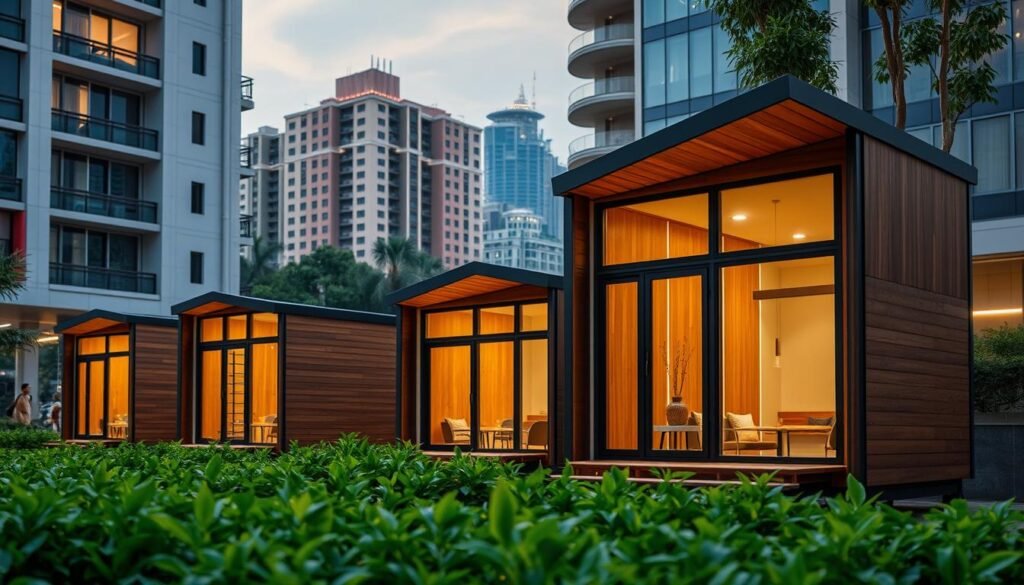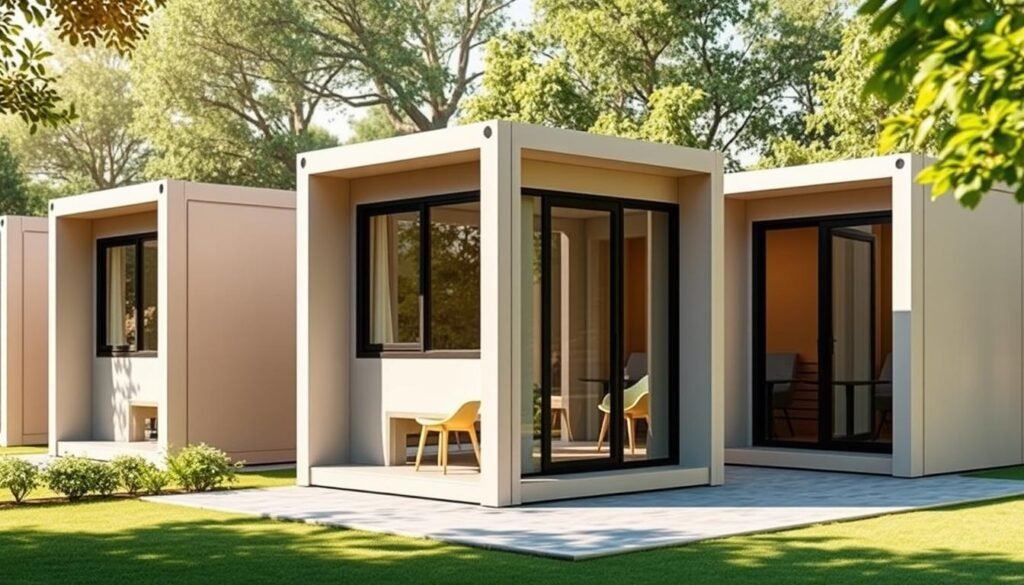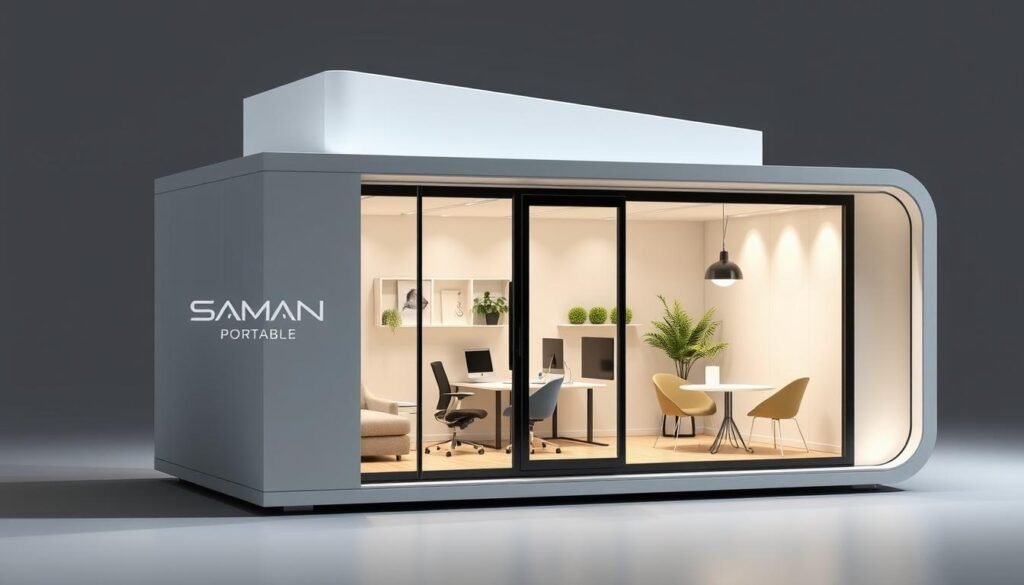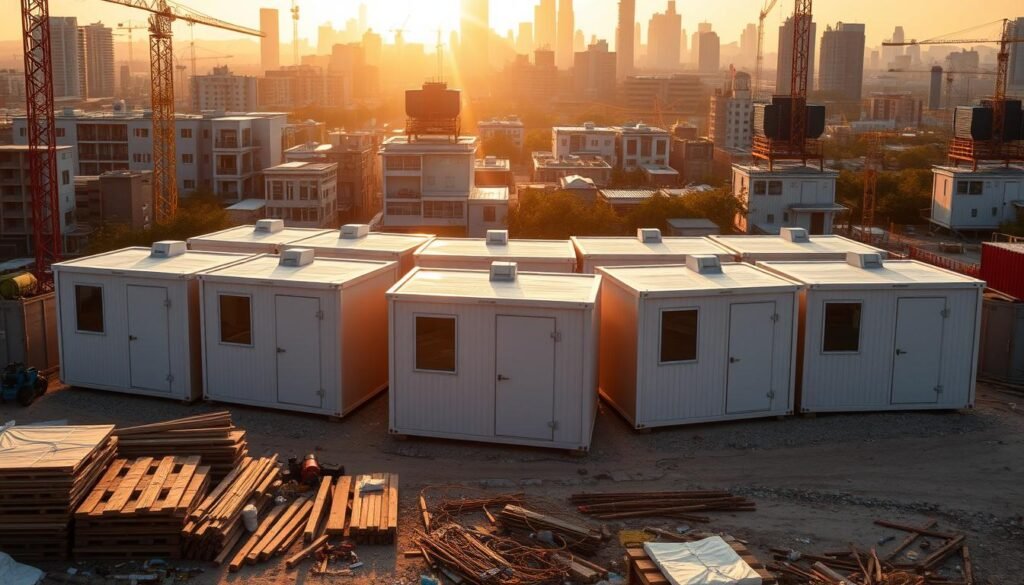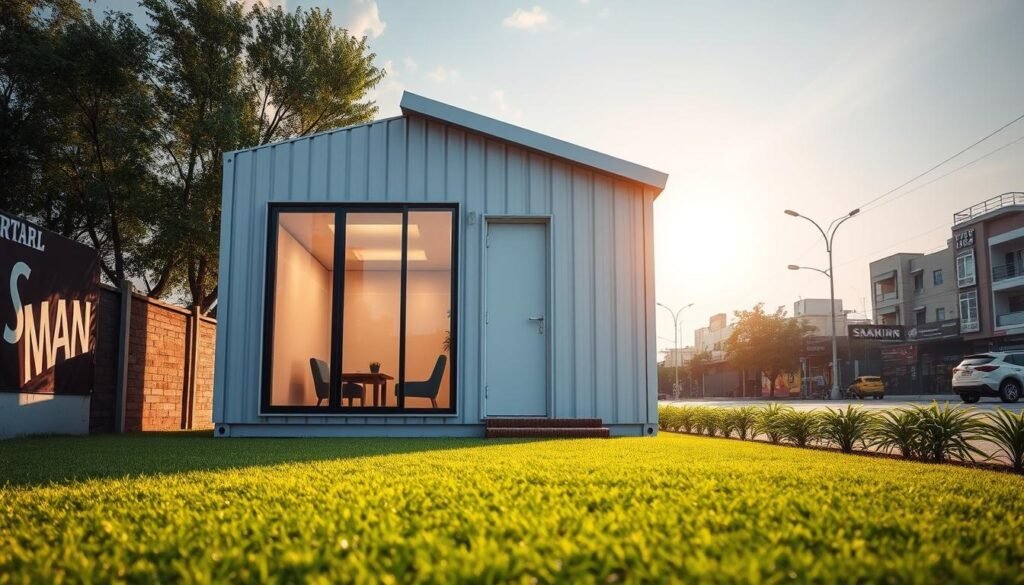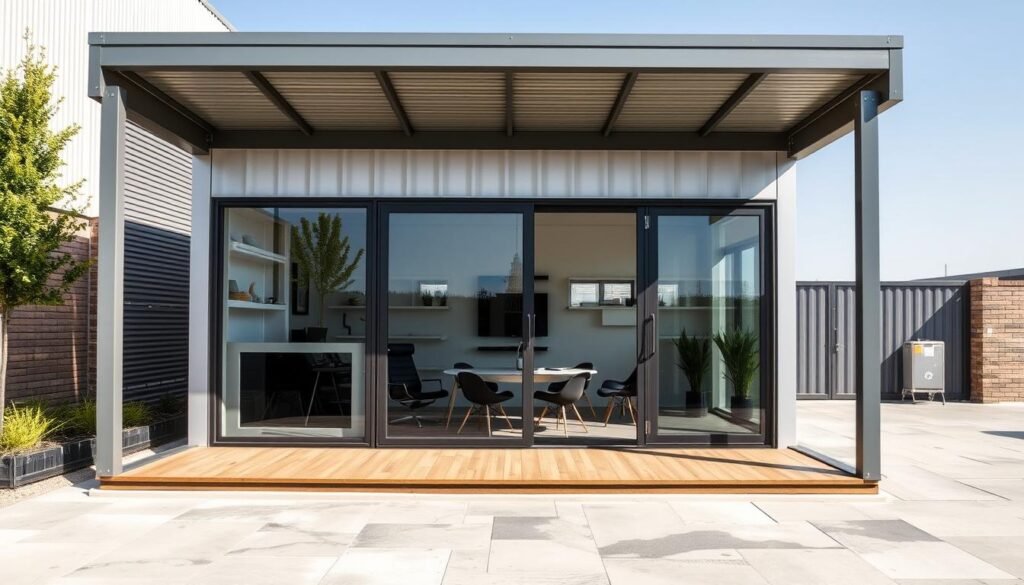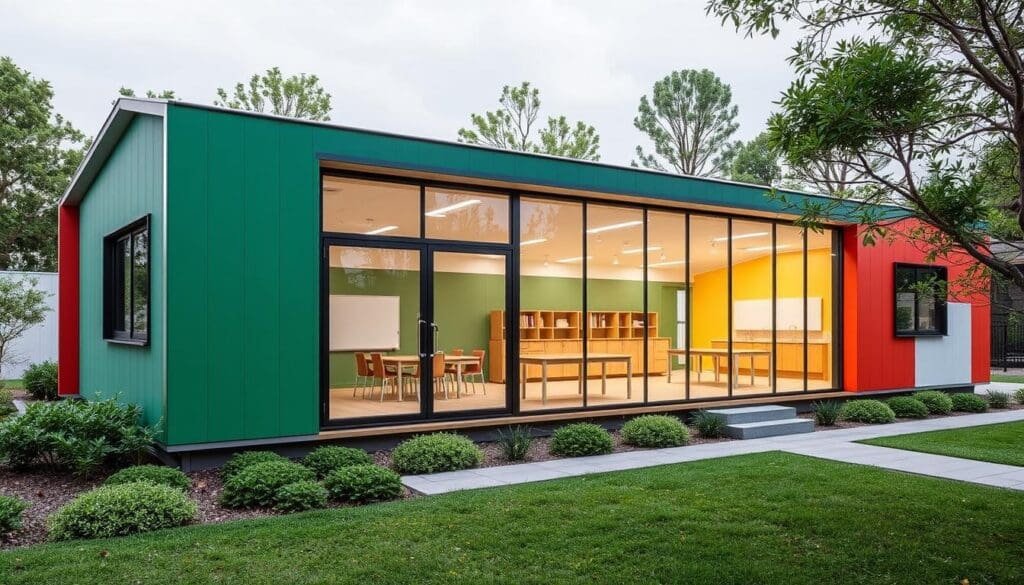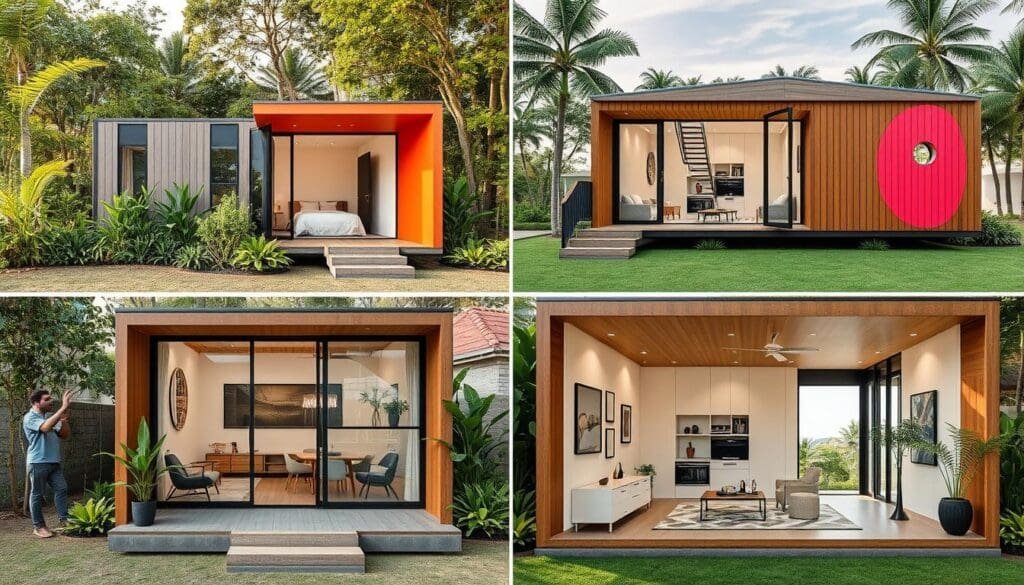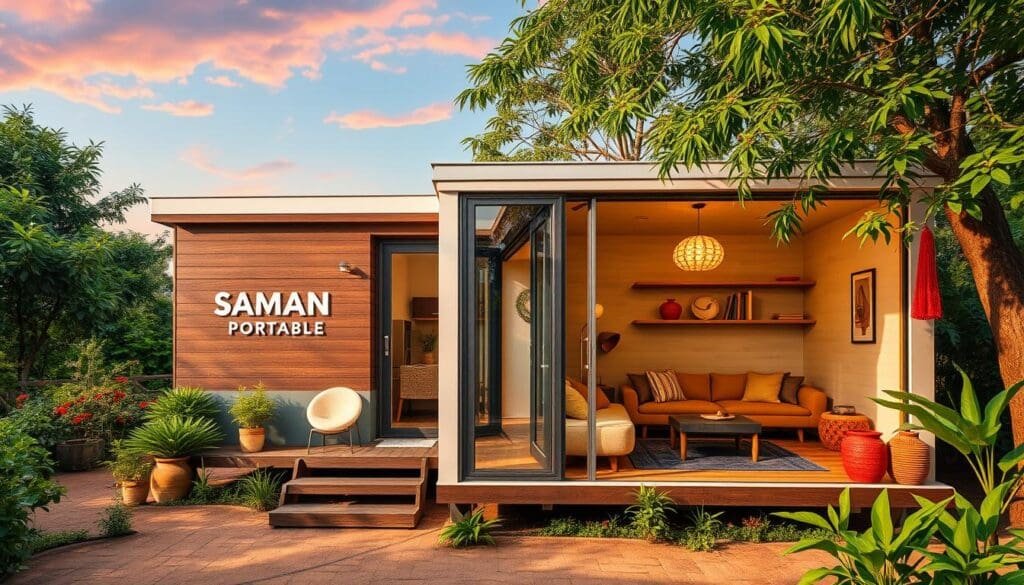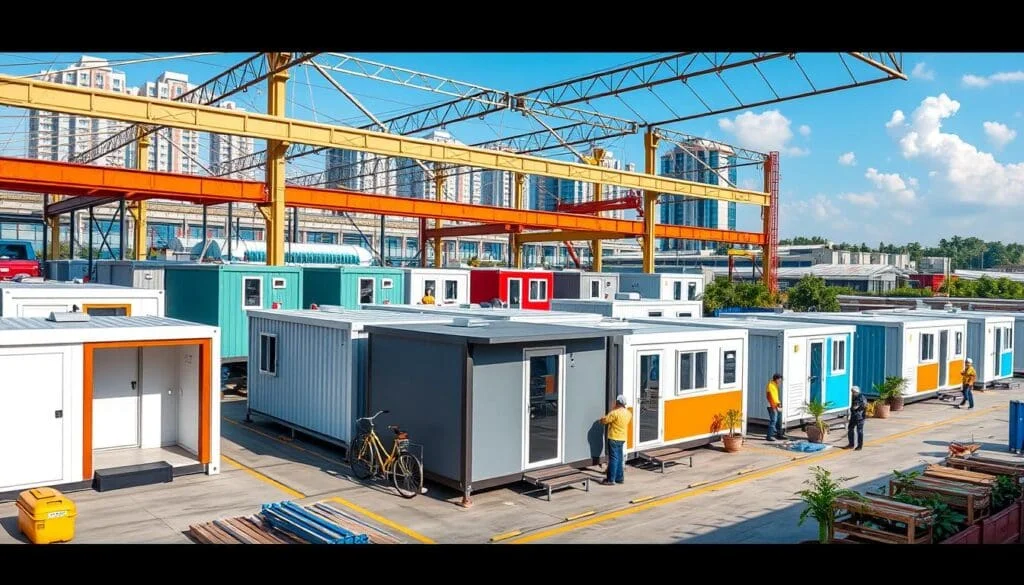Prefab Farm Homes and Farmhouses: A Guide to Modern Rural Living
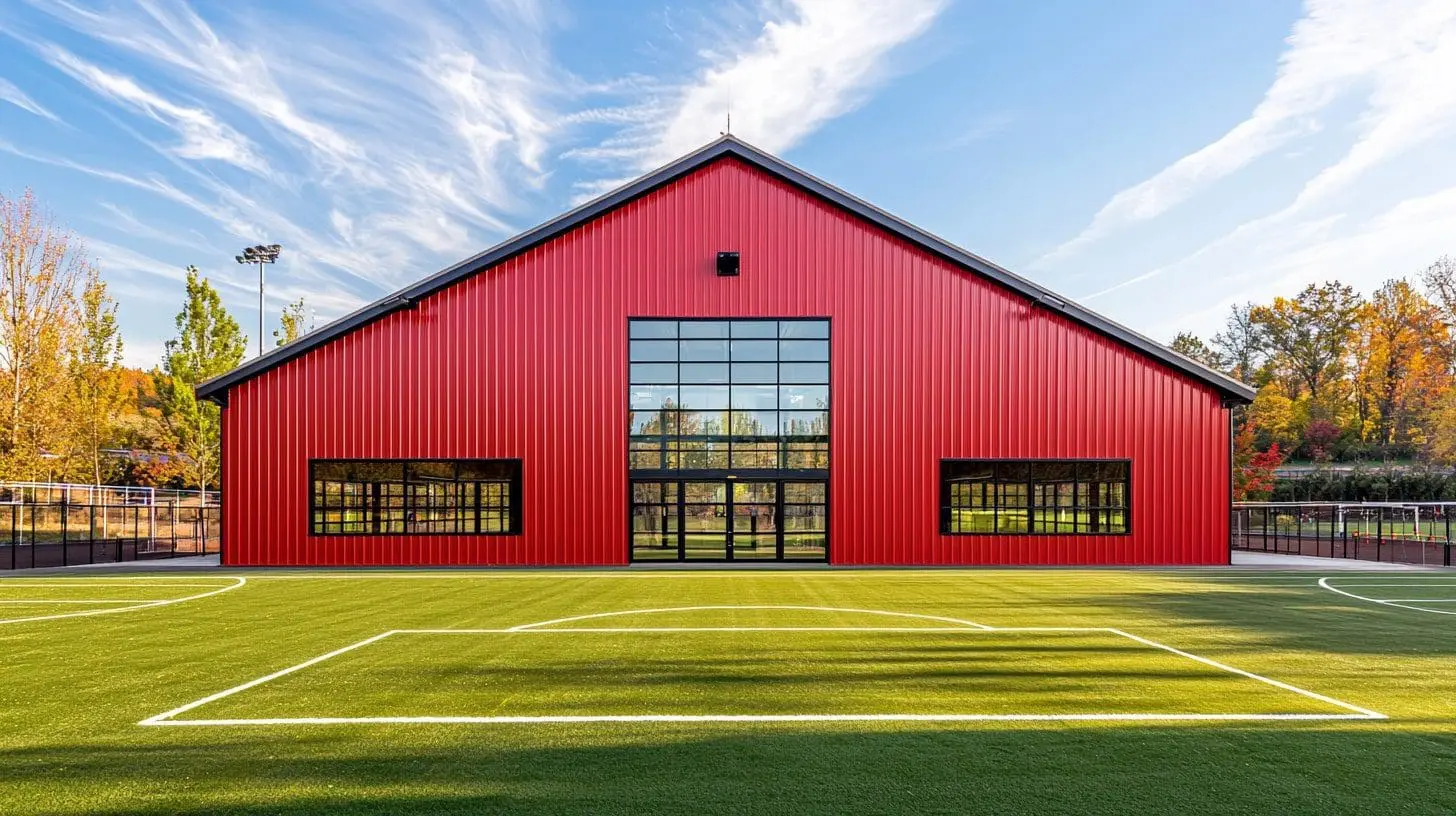
Introduction to Prefab Farm Homes and Farmhouses
Overview of Prefab Farmhouses and Their Growing Popularity
Prefab farm homes and farmhouses are transforming rural housing by providing quick-to-assemble, cost-effective, and durable solutions. These ready-made homes are built off-site in a controlled factory environment and then transported to the desired location, where they are assembled with minimal on-site construction. Prefabricated farmhouses are designed to blend seamlessly with rural and agricultural settings, offering a convenient alternative to traditional farmhouses that can be time-consuming and expensive to build.
Prefab farmhouses come with several advantages, making them an appealing choice for individuals and families looking to enjoy a countryside lifestyle or even for those who need temporary structures on agricultural land. With growing demand for rural housing solutions in India, modular prefab buildings offer modern living spaces that combine comfort with functionality, while also meeting the requirements of diverse farm settings.
Why Prefabricated Farm Homes Are Ideal for Rural Living
Prefab farmhouses are particularly suited for rural areas due to their quick setup, cost-efficiency, and low environmental impact. Unlike traditional construction, prefab homes are designed and partially built in factories, reducing labor and construction time significantly. This efficiency is especially useful in remote areas where accessing skilled labor or transporting raw materials can be challenging. For instance, container houses are a popular choice for prefab farm homes because they are durable, easy to transport, and offer a modern look that fits seamlessly within natural surroundings.
In addition to quick construction, prefab farm homes provide an eco-friendly solution by generating less waste and allowing for sustainable building materials. This aspect is vital for individuals and families in rural areas who value environmentally conscious living and seek to reduce their carbon footprint.
Key Features of Prefab Farmhouses
Prefabricated farm homes come with customizable options that cater to a variety of needs, from residential living to functional spaces like workshops, storage areas, and guesthouses. The flexibility of these homes allows owners to choose layouts and finishes that suit their specific requirements. For example, portable cabins can be used as extra rooms or guest accommodations, adding versatility to farm life without the need for extensive renovations or construction.
Prefab farmhouses also offer durability to withstand rural conditions, including options for weather-resistant materials and insulation. Whether used as a primary residence, a weekend retreat, or a workspace, these prefab structures support a variety of applications, providing functional and aesthetically pleasing living spaces in rural settings.
In the following sections, we will explore the many benefits, designs, materials, and customization options for prefab farm homes, helping you understand why they’re a practical choice for modern farm living.
Understand the structural advantages of prefab farm homes by visiting our PEB Buildings Benefits, Features & Applications page, where we outline key benefits tailored for agricultural use.
Benefits of Choosing a Prefab Farmhouse
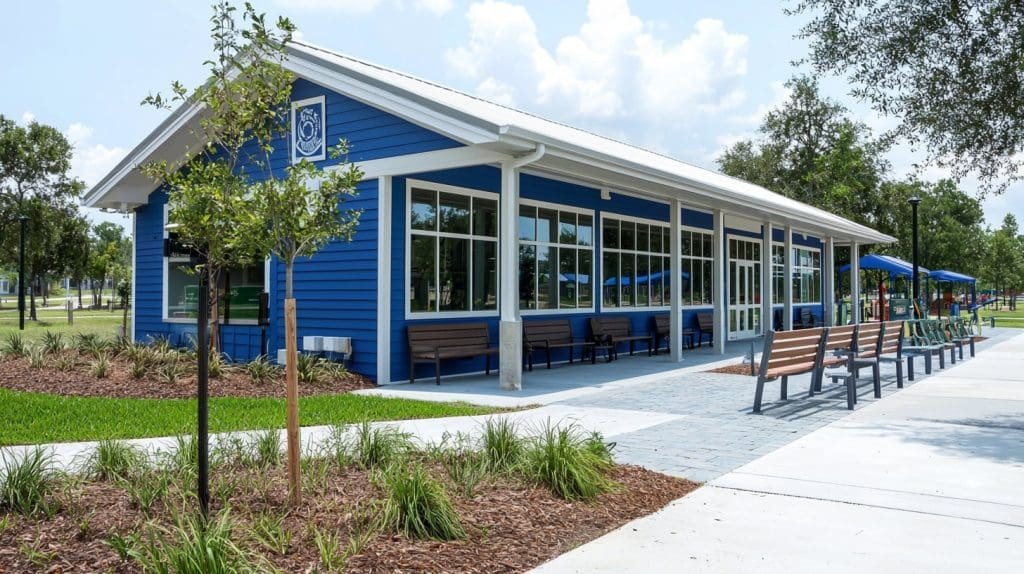
Quick Construction and Time Efficiency
One of the biggest advantages of opting for a prefab farmhouse is the swift construction process. Unlike traditional farmhouses that may require months or even years to complete, prefab farm homes are built off-site, where each component is manufactured in a factory-controlled environment. This allows for high precision and efficient resource usage, significantly reducing build time. Once the sections are ready, they’re transported to the farm site for easy assembly, making the entire setup process quick and hassle-free. For those in rural areas who want a ready-to-use living space or functional structure, modular prefab buildings provide an ideal solution with minimal delays.
This streamlined construction process is particularly beneficial for farmers or individuals who may need a swift housing solution for agricultural purposes, guest accommodations, or even as a main residence on rural land.
Cost-Effective and Budget-Friendly Option
Prefabricated farmhouses offer a cost-effective alternative to traditional farm homes, with lower initial costs due to efficient factory construction methods. The factory setting ensures that materials are used precisely, reducing waste and lowering expenses related to on-site labor. This cost-efficiency makes prefab homes a popular choice for individuals or families seeking a farm lifestyle on a budget. In addition, options like container houses offer an affordable yet sturdy solution that fits seamlessly into farm settings without compromising on quality or functionality.
For those looking to invest in a durable and affordable farmhouse, prefab structures offer excellent value for money, allowing for customization and design flexibility without the high expenses associated with traditional construction.
Eco-Friendly and Sustainable Construction
Prefab farm homes are also known for their eco-friendly characteristics, making them an excellent choice for those interested in sustainable rural living. The construction process generates less waste and uses fewer resources, helping to reduce the environmental impact. Additionally, many prefab farmhouses use sustainable materials, such as treated steel, wood, and composite panels, which support greener building practices. For instance, portable cabins can be designed with energy-efficient insulation and renewable options like solar panels, further promoting sustainability on the farm.
This sustainable approach appeals to those seeking to minimize their carbon footprint while enjoying the benefits of rural living. With customization options, prefab farm homes can include energy-saving features, making them both eco-conscious and cost-effective over the long term.
Low Maintenance and Long-Lasting Durability
Prefab farmhouses are built with durable, weather-resistant materials that require minimal maintenance, which is especially important for rural properties. Unlike traditional wooden farmhouses, which can be prone to rot, termites, and frequent repairs, prefab structures are crafted to withstand various weather conditions with little upkeep. Many portable cabins and other prefab farm buildings incorporate moisture-resistant materials and sturdy frameworks, making them suitable for long-term use in rural environments.
For rural homeowners, the durability and low-maintenance nature of prefab farm homes mean fewer repair costs and a structure that will stand the test of time, making them a smart investment in any rural setting.
Elevate your farm home designs with our Design of PEB Structure: Key Elements guide, ensuring your prefab homes are both functional and durable.
Design Options for Prefab Farm Homes
Modern, Rustic, and Traditional Styles for Diverse Tastes
Prefab farm homes come in a range of styles that cater to various aesthetic preferences, allowing homeowners to select designs that best suit their farm’s character and the surrounding landscape. Whether you’re drawn to the clean lines of a modern farmhouse, the warmth of rustic décor, or the classic look of a traditional farm home, prefabricated structures offer flexible design options. Modular prefab homes, for instance, can be customized with both contemporary and rustic finishes to seamlessly blend with natural rural settings. This flexibility makes modular prefab buildings an ideal solution for those seeking style without compromising functionality.
Each design choice can be further enhanced with features like wood paneling, stone cladding, or open spaces, allowing residents to create a farmhouse that reflects their personal taste.
Functional Layouts for Rural Lifestyles
The design of prefab farm homes often incorporates functional layouts that cater to the needs of rural living. For instance, open-plan designs with expansive kitchens and cozy living areas provide practical spaces that suit farm lifestyles. Prefab farmhouses can also include large verandas, covered patios, and outdoor seating areas that extend the living space and allow residents to enjoy the countryside views. Such layouts enhance both comfort and functionality, making container houses a popular choice for those seeking versatile indoor-outdoor living options.
This adaptability allows homeowners to configure spaces based on specific needs, whether they require extra rooms for guests, a workshop area, or additional storage for farm supplies.
Options for Large Windows and Natural Light
Prefab farm homes can be designed with large windows and glass doors that invite ample natural light into the living spaces, reducing the need for artificial lighting and creating a brighter, more open atmosphere. These windows also provide beautiful views of the surrounding farmland, making the home feel more connected to its natural environment. Many portable cabins can be fitted with expansive windows, which not only improve the home’s aesthetics but also enhance energy efficiency by promoting natural ventilation.
Natural lighting and open views make prefab farmhouses feel spacious, enhancing the overall quality of life for residents who value close proximity to nature.
Customizable Interiors for a Personal Touch
One of the major advantages of prefab farm homes is the ability to customize interior elements to create a personalized living space. Homeowners can choose from a variety of finishes, wall colors, flooring options, and fixtures to achieve their desired look. Whether you prefer a minimalist design or a farmhouse-style interior with wood accents and warm colors, prefab farmhouses offer endless customization possibilities. Portable cabins, for example, can be tailored with unique finishes and decor elements, allowing residents to craft spaces that feel distinct and homely.
For rural homeowners, these customization options mean the ability to create a farmhouse that combines both personal style and the practicality needed for farm life.
Outdoor Extensions and Additional Structures
For those who want even more versatility, prefab farm homes can include outdoor extensions such as tool sheds, greenhouses, and barns, which are invaluable for agricultural and rural living. Many prefab manufacturers offer modular extensions that can be added based on the needs of the homeowner, creating a fully integrated farm property. These additional structures complement the farmhouse design, providing functional space for storage, animal care, or even guest accommodations, enhancing the farmhouse’s overall utility.
In summary, the design flexibility of prefab farm homes makes them a practical choice for rural homeowners who desire both aesthetic appeal and functional space for an active farm lifestyle.
Connect with reliable manufacturing partners by exploring our PEB Building Manufacturers in India list, featuring top-tier manufacturers dedicated to quality.
Materials and Construction Techniques for Prefab Farmhouses
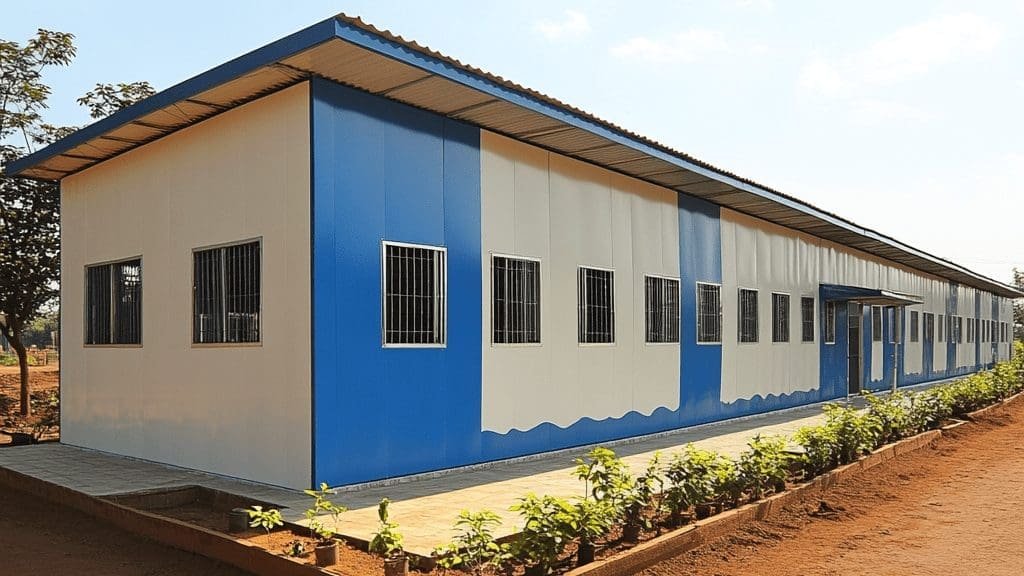
Durable Materials for Long-Lasting Farmhouses
Prefab farmhouses are constructed using high-quality materials that are specifically chosen to withstand the demands of rural environments. Common materials include treated steel, engineered wood, and weather-resistant composite panels. These materials provide the structural durability needed to handle the varied conditions of farm life, from fluctuating temperatures to exposure to outdoor elements. Modular prefab buildings, for example, are often built with corrosion-resistant steel frames and reinforced walls, ensuring that the structure remains resilient over time.
Using such durable materials reduces maintenance needs, an important benefit for rural homeowners who want a low-maintenance yet long-lasting farm home.
Weather-Resistant Features Ideal for Rural Settings
Prefab farmhouses are designed to handle diverse weather conditions, making them ideal for rural settings where exposure to the elements is constant. Materials like moisture-resistant wood and UV-protected composite panels prevent damage from sun, rain, and humidity, which are common in rural areas. This protection is particularly valuable for prefab homes in farming regions that experience seasonal weather changes. Many container houses are engineered with weatherproof exteriors that withstand wind, rain, and other outdoor elements, ensuring longevity and minimal upkeep.
For farm owners, these weather-resistant features mean fewer repairs and a stable structure that can endure for years, regardless of environmental factors.
Insulation and Ventilation for Comfort and Energy Efficiency
A key component of prefab farmhouse construction is efficient insulation and ventilation. Quality insulation materials are incorporated into the walls, floors, and roofs to regulate indoor temperatures and reduce energy consumption. In rural areas, where heating and cooling may be limited, insulated prefab homes provide comfortable living conditions throughout the year. Additionally, ventilation options, such as cross-ventilation windows and attic vents, improve airflow, creating a fresh, comfortable interior. Many portable cabins come with insulation and ventilation upgrades, which are essential for maintaining a comfortable, energy-efficient living space.
These energy-efficient features not only enhance comfort but also contribute to lower energy costs, making prefab farmhouses both eco-friendly and cost-effective.
Moisture Control and Protection from Pests
In rural settings, prefab farmhouses are often exposed to moisture from rainfall, humidity, and soil. To counteract this, prefab homes use moisture-resistant materials and construction techniques that prevent mold and mildew buildup, protecting the integrity of the structure. Materials like treated wood and moisture-barrier layers are common in portable cabins, providing added durability in damp conditions. Additionally, prefab farmhouses are designed to minimize pest issues with secure door seals, screened windows, and pest-resistant materials, reducing the likelihood of insect or rodent intrusion.
These protective elements are vital for farmhouses located on agricultural land, where pests and moisture are more prevalent.
Construction Techniques that Enhance Structural Integrity
The construction techniques used in prefab farmhouses focus on creating stable, resilient structures that can handle the demands of rural living. Advanced techniques, like modular framing and reinforced joint systems, provide the structural integrity needed for a long-lasting farmhouse. Factory construction ensures precision in every component, reducing the chance of errors and creating a more stable home. Many modular prefab buildings are manufactured with precise measurements and reinforced materials that ensure a solid and secure structure.
This approach not only improves the structural strength of prefab homes but also enhances their longevity, offering rural homeowners a safe, durable, and reliable housing option.
In essence, the materials and construction techniques used in prefab farmhouses make them a practical choice for rural settings, providing resilience, comfort, and low-maintenance benefits tailored for farm life.
Expand your prefab housing insights by reading about our Prefabricated Houses in Hyderabad projects, showcasing successful implementations in Hyderabad.
Cost Comparison: Prefab Farm Homes vs. Traditional Farmhouses
Lower Initial Construction Costs
One of the primary advantages of choosing a prefab farmhouse over a traditional build is the lower initial cost. Prefab farm homes are built in a controlled factory environment, allowing manufacturers to minimize material waste and optimize labor, reducing costs significantly. By contrast, traditional farmhouses require more on-site labor and material handling, often leading to higher expenses due to delays, material wastage, and longer construction timelines. For those seeking an affordable rural retreat or farm residence, modular prefab buildings offer a cost-effective solution that doesn’t sacrifice quality.
The reduced initial construction costs make prefab homes a suitable choice for budget-conscious buyers, enabling them to achieve high-quality rural housing at a fraction of the cost.
Savings on Labor and Construction Time
Prefab farm homes offer substantial savings on labor costs compared to traditional builds. The factory-based manufacturing process allows for faster assembly and significantly reduces the need for on-site labor, which can be both costly and challenging to manage in rural locations. Additionally, because prefab homes are partially assembled off-site, the timeline from start to finish is much shorter, leading to fewer labor hours overall. Container houses, for instance, are quick to transport and assemble, making them ideal for farm owners who need a functional structure without the long wait time associated with traditional construction.
For rural homeowners, this efficient construction process translates into both time and cost savings, as the entire build can often be completed within weeks instead of months.
Long-Term Maintenance and Durability Savings
Prefab farmhouses are generally designed to be low-maintenance, utilizing materials that are resistant to common issues like moisture damage, pests, and weather-related wear. Traditional farmhouses often require regular upkeep, which can add up in terms of both cost and time, especially in rural areas where resources may be limited. By choosing a prefab farmhouse, homeowners benefit from durable, weather-resistant materials that reduce the need for ongoing maintenance. Many portable cabins and prefab modular units are built with protective coatings and reinforced structures that enhance longevity, further lowering maintenance costs over time.
This durability and low maintenance aspect provide long-term financial benefits, making prefab farm homes a more economical choice in the long run.
Energy Efficiency and Utility Savings
Prefab farm homes are often equipped with energy-efficient features that help to reduce utility costs over time. With better insulation, energy-saving windows, and ventilation systems, prefab homes can maintain comfortable indoor temperatures with less reliance on heating or cooling systems. This energy efficiency is particularly beneficial in rural areas, where energy resources can be limited, and costs may be higher. Portable cabins and other prefab units can be customized with energy-efficient options, further reducing monthly utility expenses for rural homeowners.
These savings on utilities contribute to the overall affordability of prefab homes, offering both initial and ongoing cost benefits that make them a wise investment for those in rural settings.
Value for Money with Customizable Options
Prefab farm homes offer excellent value for money by providing customizable options that meet specific needs without added costs. Homeowners can tailor layouts, finishes, and additional features without exceeding their budget, a flexibility often unavailable in traditional construction. This customization allows homeowners to create a rural living space that is both functional and cost-effective, whether they need extra storage, guest accommodations, or an open-plan layout suited for farm life.
In summary, the affordability and cost-saving features of prefab farm homes make them an attractive option for rural buyers looking to maximize their investment without compromising on quality.
Discover diverse prefab solutions by exploring our Prefabricated Houses in Kerala guide, highlighting successful projects in Kerala.
Sustainable and Eco-Friendly Aspects of Prefab Farmhouses
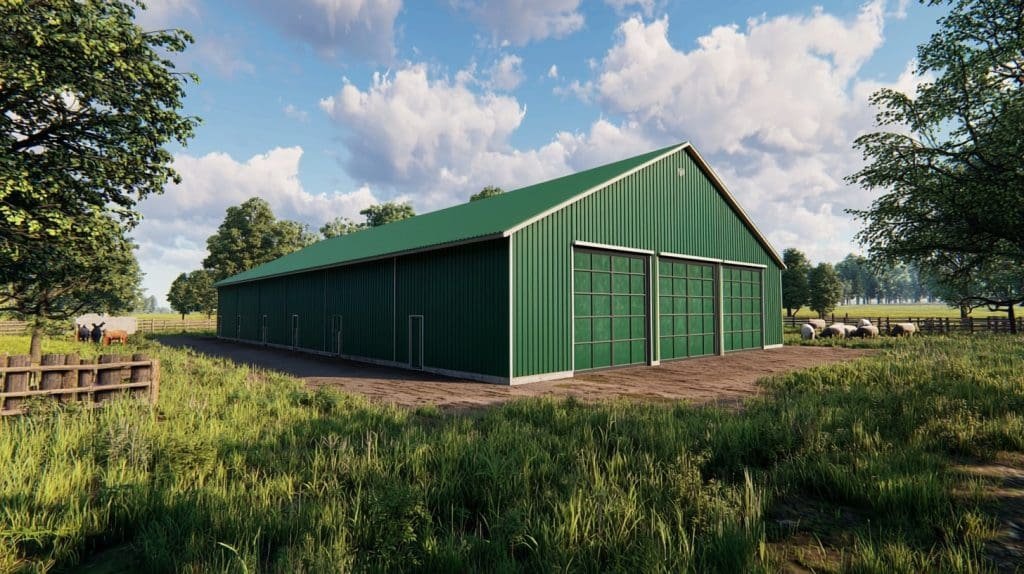
Eco-Conscious Construction Process
Prefabricated farmhouses are widely recognized for their environmentally friendly construction process, which aligns well with sustainable practices in rural settings. Unlike traditional homes that are built on-site, prefab farmhouses are manufactured in a factory environment, allowing for greater control over resource usage and minimizing material waste. This factory-based approach reduces the environmental impact significantly by lowering emissions associated with on-site construction, transportation, and excess waste. Many modular prefab buildings are designed to be energy-efficient and environmentally responsible, making them an excellent choice for those who prioritize sustainable living.
For rural homeowners focused on eco-conscious living, choosing a prefab farmhouse is a meaningful way to support greener building practices while enjoying the benefits of efficient construction.
Use of Sustainable and Recyclable Materials
Prefab farmhouses are often constructed using sustainable and recyclable materials that enhance their eco-friendly appeal. Common materials include steel, engineered wood, and composite panels, all of which are chosen for their longevity, recyclability, and minimal environmental impact. For example, container houses use repurposed shipping containers, giving new life to previously used materials while creating a durable and adaptable living space. This repurposing helps reduce the demand for new raw materials, contributing to a smaller environmental footprint.
Additionally, prefab structures allow for the use of eco-friendly materials like bamboo and reclaimed wood, which are both sustainable and aesthetically pleasing, providing rural homeowners with green building choices that don’t compromise style or functionality.
Energy-Efficient Design Features
Prefab farm homes are designed with energy efficiency in mind, incorporating features that reduce energy consumption and utility costs. These homes often come with high-quality insulation in the walls, roofs, and floors, which helps regulate indoor temperatures, reducing the need for artificial heating or cooling. Energy-efficient windows, ventilation systems, and options for solar panel installation further support sustainable energy use. Many portable cabins can be outfitted with these energy-efficient features, allowing homeowners to reduce their environmental impact and energy costs, especially important in rural areas where electricity may be sourced from non-renewable grids.
These energy-efficient design features not only contribute to cost savings but also align with broader sustainability goals, making prefab farmhouses a responsible choice for those looking to minimize their carbon footprint.
Options for Renewable Energy and Water Conservation
Prefabricated farmhouses can also be customized with renewable energy systems and water-saving features, enhancing their suitability for sustainable rural living. Many prefab homes are compatible with solar panel systems, enabling homeowners to harness clean energy and reduce dependence on traditional power sources. In addition, rainwater harvesting systems and low-flow water fixtures can be installed, helping to conserve water resources in areas where availability may be limited. Portable modular units can incorporate these sustainable solutions, providing a self-sufficient setup that supports rural lifestyles.
These customizations make prefab farmhouses a practical choice for rural residents who want to make the most of natural resources while minimizing environmental impact.
Reduced On-Site Environmental Disruption
The factory-based construction of prefab farm homes means less disruption to the natural landscape, which is especially beneficial for rural properties where preserving the local ecosystem is essential. Prefabricated homes require minimal on-site assembly, which reduces soil erosion, air pollution, and noise, allowing the natural surroundings to remain largely undisturbed. This approach benefits both the land and local wildlife, supporting a healthier environment around the farmhouse.
Overall, the sustainable and eco-friendly features of prefab farmhouses make them a compelling choice for rural homeowners seeking to embrace greener living practices, reduce their environmental footprint, and enjoy the benefits of efficient, cost-effective construction.
Gain inspiration from our Prefabricated House in Pune Overview page, which showcases effective prefab projects in Pune.
Popular Locations for Prefab Farm Homes in India
Maharashtra: Embracing Modern Farmhouse Living
Maharashtra, with its vast rural landscape and agricultural heritage, is one of the top regions in India for prefab farm homes. Areas like Pune, Nashik, and the Konkan coast have seen a growing interest in prefab farmhouses due to their affordability, durability, and suitability for diverse terrains. Maharashtra’s blend of urban and rural regions makes prefab homes an attractive choice for both city dwellers looking for weekend retreats and full-time rural residents seeking a modern farm lifestyle. Modular prefab buildings have become increasingly popular in Maharashtra, as they allow for quick assembly and offer weather-resistant options that handle both the monsoon season and the region’s dry climate.
This flexibility makes Maharashtra a prime location for prefab homes, meeting the needs of everyone from farmers to urban professionals seeking a connection to nature.
Karnataka: Sustainable Rural Living in the South
In Karnataka, prefab farm homes are gaining traction in both rural and semi-urban areas, especially near cities like Bangalore, Mysore, and Chikmagalur. Known for its scenic landscapes and eco-conscious population, Karnataka provides an ideal setting for sustainable prefab farmhouses that cater to residents interested in eco-friendly living. Many container houses are being used as functional and aesthetically pleasing farmhouses in Karnataka’s coffee and spice-growing regions, where natural surroundings are highly valued. These prefab homes allow homeowners to build sustainably without disrupting the local environment, aligning with Karnataka’s green building initiatives.
Prefab farm homes in Karnataka support the state’s focus on environmentally responsible living, offering residents an option that reduces waste and promotes resource conservation.
Rajasthan: Prefab Farm Homes for Harsh Climates
Rajasthan’s challenging desert climate and expansive farmland make prefab farmhouses a practical option for residents seeking durability and efficiency. Prefab homes are well-suited for the dry, arid conditions of Rajasthan, offering materials and design options that withstand extreme temperatures and sandstorms. Prefab homes with insulated walls and efficient ventilation systems help maintain comfortable indoor temperatures, providing a cost-effective and resilient solution for rural living. Many residents in Rajasthan choose portable cabins as guest accommodations or additional farm structures, given their quick setup and ability to endure harsh weather.
The adaptability of prefab farm homes in Rajasthan supports both agricultural needs and tourism, making them ideal for multi-purpose use across the state.
Himachal Pradesh: Mountain-Ready Prefab Farmhouses
In the mountainous regions of Himachal Pradesh, prefab farm homes have become a popular choice due to their ability to be customized for difficult terrains. Areas like Shimla, Manali, and Dharamshala attract both tourists and residents who seek mountain-ready homes that can be assembled with minimal impact on the land. Prefab structures are particularly advantageous in these high-altitude areas, where traditional construction may be limited by seasonal constraints and challenging access routes. Portable modular units offer an efficient solution for setting up homes or guest cabins in these mountainous regions, allowing for quick installation and adaptability to steep slopes.
The versatility of prefab homes in Himachal Pradesh supports the state’s eco-tourism industry and provides residents with comfortable, weather-resistant housing that complements the natural landscape.
Kerala: Prefab Homes in Tropical Environments
Kerala’s tropical climate and strong emphasis on eco-friendly practices make it an excellent location for prefab farm homes. Prefab structures can withstand Kerala’s high humidity and monsoon rains while providing residents with sustainable, low-maintenance living spaces. In areas like Wayanad and Alleppey, where eco-tourism and agriculture thrive, portable cabins are frequently used as vacation homes, guest accommodations, and farming-related structures. These prefab homes support Kerala’s commitment to sustainable development, offering an environmentally conscious option that fits well in the state’s lush, green landscapes.
The demand for prefab homes in Kerala highlights their suitability for tropical conditions, blending sustainability with functional design for rural and semi-urban applications.
Across India, prefab farm homes are being embraced for their efficiency, cost-effectiveness, and adaptability to various landscapes, making them an ideal solution for modern rural living.
Stay ahead with modern construction methods by consulting our Precast Housing Construction Guide, designed for contemporary building practices.
Customization Options for Prefabricated Farmhouses
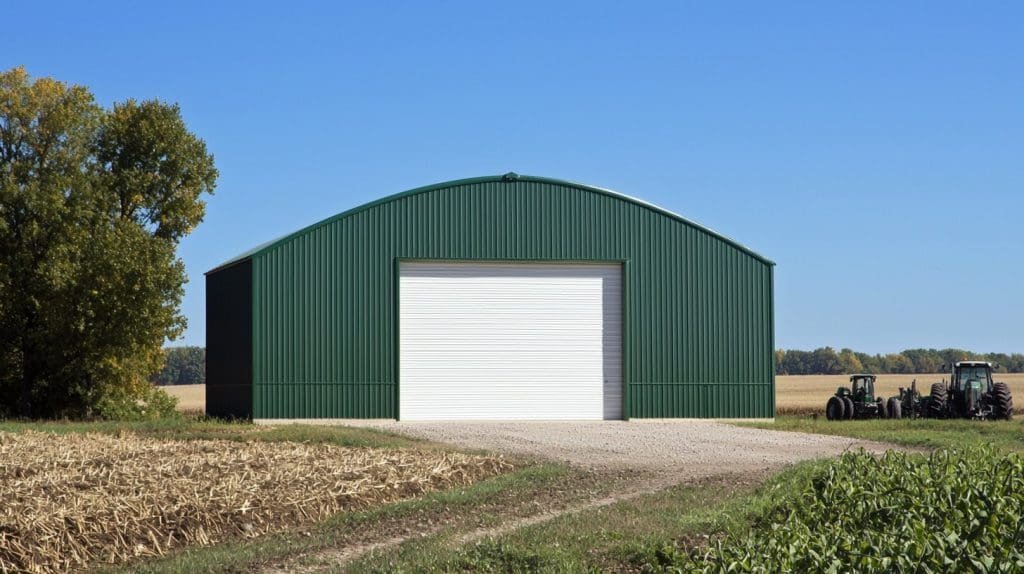
Flexible Layouts to Match Rural Lifestyles
One of the greatest appeals of prefab farmhouses is the ability to customize layouts according to specific needs. Whether homeowners are looking for open-plan designs to create spacious living areas or additional rooms for storage and agricultural use, prefab farm homes offer versatile configurations. These flexible layouts allow farm owners to choose room arrangements that best suit their lifestyle and operational needs. Modular prefab buildings are especially customizable, with options to incorporate kitchens, large dining areas, and outdoor seating spaces, ideal for those seeking a balance of functionality and comfort.
By selecting specific room placements, homeowners can create farmhouses that cater to everything from family gatherings to efficient storage solutions, aligning with both personal and professional needs.
Personalized Interior and Exterior Finishes
Prefab farmhouses provide a wide range of finishes for both interiors and exteriors, allowing owners to personalize the look and feel of their home. From rustic wood paneling and stone textures to sleek modern designs, homeowners can choose finishes that complement the natural surroundings or reflect their personal style. For instance, container houses can be customized with cladding, paint, or timber accents, creating a unique aesthetic that merges modernity with the rural landscape. Interior options include flooring, wall colors, cabinetry, and fixtures, enabling residents to create a comfortable and inviting farmhouse.
This variety in finish options allows farm owners to maintain an aesthetic that’s both practical and aligned with their vision for a rural retreat or working farm.
Outdoor Features and Extensions for Farm Utility
In addition to interior flexibility, prefab farmhouses can be equipped with outdoor features that enhance their utility for farm life. Customizable options such as verandas, covered patios, tool sheds, and even greenhouses provide practical spaces for farm-related tasks, storage, or relaxation. These outdoor extensions support both everyday farm operations and recreational needs, offering extra space for tools, machinery, and relaxation areas. Many portable cabins come with optional add-ons like porches and pergolas, creating multi-functional outdoor areas that seamlessly blend with the farmhouse.
These outdoor additions make prefab farmhouses not only more versatile but also highly suited to the demands of rural and agricultural living.
Energy-Efficient and Sustainable Customizations
With a growing interest in sustainable living, many prefab farmhouses are designed to incorporate energy-efficient features. Homeowners can choose to add solar panels, rainwater harvesting systems, and efficient insulation to reduce energy consumption and support green living. Portable modular units are often compatible with these eco-friendly features, making them an attractive choice for farm owners looking to minimize their environmental footprint. Energy-efficient windows, ventilation systems, and smart home technology can also be integrated, providing a modern touch to the farmhouse.
These sustainable customizations help reduce energy bills and contribute to eco-friendly practices, aligning with the goals of rural residents who value responsible resource usage.
Adaptable Spaces for Farm and Family Needs
Prefab farmhouses offer adaptable spaces that can be modified to meet both family and farm needs, from additional bedrooms and bathrooms to dedicated spaces for hobbies or agricultural activities. This adaptability ensures that prefab homes are not only living spaces but also support various farm operations, including storage, workshops, and guest accommodations. For those who host family gatherings or agricultural events, the ability to customize spaces ensures that the farmhouse can serve multiple functions, adding significant value for rural residents.
In summary, the customizable nature of prefab farmhouses enables homeowners to design homes that truly cater to their individual needs, making them a practical and personal choice for modern farm living.
Address urban construction needs with our Prefab Homes Mumbai Guide, offering strategies tailored for the vibrant Mumbai landscape.
Key Considerations When Buying a Prefab Farmhouse
Setting a Realistic Budget
When planning to buy a prefab farmhouse, establishing a realistic budget is a critical first step. While prefab farm homes are generally more affordable than traditional construction, costs can vary significantly depending on design choices, materials, and location. It’s essential to consider all potential expenses, including transportation fees, site preparation, and any additional customization options. By understanding the financial requirements, buyers can ensure they get a farmhouse that meets their needs without exceeding their budget. Comparing quotes from various manufacturers and considering options like modular prefab buildings can help in making an informed decision that aligns with one’s budget and preferences.
Setting a clear budget ensures that buyers can enjoy both affordability and quality without the risk of unexpected expenses.
Choosing the Right Site and Preparing for Installation
Selecting the appropriate site for a prefab farmhouse is essential to the home’s functionality and longevity. Rural and agricultural areas often require proper land preparation, including ground leveling, soil assessment, and ensuring accessibility for the delivery and installation of prefab sections. Preparing the site in advance helps avoid delays and ensures a smooth setup process. Additionally, checking for utility access, such as water and electricity connections, is crucial for making the home move-in ready. Container houses, for instance, may require minimal groundwork, making them a convenient option for sites with limited preparatory needs.
Preparing the site properly helps to secure a stable foundation, maximizing the durability and stability of the prefab farmhouse.
Understanding Local Zoning Regulations and Permits
Before buying a prefab farmhouse, it’s essential to check local zoning regulations and obtain the necessary permits. Zoning laws and building codes can vary widely, especially in rural areas, so understanding these regulations will help ensure that the prefab home complies with all legal requirements. Some rural zones may have specific restrictions on certain types of structures, or requirements for agricultural use. For instance, portable cabins may have different permit requirements compared to permanent farm structures. Consulting with local authorities and the prefab manufacturer will help clarify these regulations and streamline the setup process.
Compliance with local rules and regulations ensures that the farmhouse is legally authorized and ready for occupancy, reducing the risk of future complications.
Selecting a Reliable Manufacturer
Choosing a reputable prefab manufacturer is crucial to ensuring the quality and durability of a farmhouse. Prospective buyers should research potential manufacturers, check reviews, and if possible, visit sample homes to get a firsthand look at build quality. A reliable manufacturer will offer warranties, post-purchase support, and transparency regarding materials and construction practices. Many portable modular units come with warranties that cover structural integrity and material durability, providing homeowners with peace of mind.
Working with a trusted manufacturer guarantees that the prefab home meets high standards and can withstand the demands of rural and agricultural life.
Planning for Long-Term Maintenance
While prefab farmhouses are generally low-maintenance, regular upkeep is still necessary to ensure they remain in optimal condition. Many prefab homes are constructed with durable, weather-resistant materials, but routine checks on insulation, exterior finishes, and ventilation systems are recommended. Rural homeowners may also need to consider additional maintenance for structures exposed to the elements or used for agricultural purposes. By understanding the maintenance needs in advance, buyers can plan for long-term care that ensures their prefab farmhouse continues to meet their needs over time.
Considering these key factors helps prospective buyers make an informed decision when purchasing a prefab farmhouse, ensuring that it’s a lasting, comfortable, and efficient investment for rural living.
For a complete overview of prefab farm homes benefits and features, revisit our PEB Buildings Benefits, Features & Applications page. It’s your go-to resource for all PEB-related information.
Future Outlook for Prefab Farm Homes in India
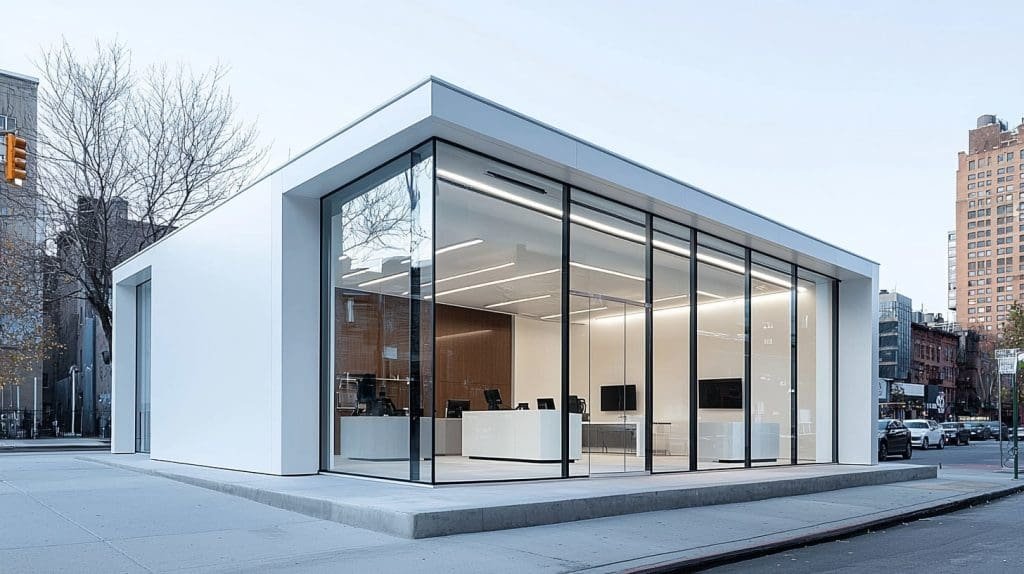
Rising Demand for Sustainable and Affordable Housing
With the rising need for sustainable, affordable housing, the future of prefab farm homes in India looks promising. As more people recognize the benefits of prefab construction—ranging from quicker assembly to reduced environmental impact—prefab farmhouses are becoming a practical and desirable option for rural and urban residents alike. In regions with significant agricultural communities, these homes offer a modern solution that aligns with environmental goals. Modular prefab buildings are well-suited for farms and rural spaces, where they provide efficient housing with lower costs and minimal ecological disruption.
The increasing demand for affordable, durable housing in rural areas is expected to drive further growth in the prefab sector, making these homes an attractive option for a broad spectrum of buyers.
Advances in Technology Enhancing Prefab Homes
Technological advancements are shaping the future of prefab homes, offering greater customization, efficiency, and sustainability. With innovations like 3D printing, Building Information Modeling (BIM), and advanced materials, prefab construction is becoming more precise and adaptable. These technologies allow homeowners to visualize and customize their farm homes to meet specific needs, improving the efficiency of the design and construction process. As technology continues to evolve, prefab farm homes are likely to incorporate more smart features, from automated lighting to climate control systems, making them a practical and modern choice for rural living. Container houses, for instance, are expected to benefit from these advancements, becoming more energy-efficient and versatile.
These technological improvements will make prefab farmhouses more appealing to residents seeking smart, sustainable homes that meet modern expectations.
Increased Focus on Eco-Friendly Building Solutions
As India increasingly focuses on eco-friendly and green building practices, prefab farm homes stand out as a sustainable choice. Prefabricated construction significantly reduces waste, cuts down on material usage, and often incorporates recycled or renewable materials. Many prefab homes are now designed to support energy-efficient systems, including solar panels, rainwater harvesting, and efficient insulation, which all contribute to reducing their environmental footprint. Portable cabins are often customized with these green features, aligning with the growing interest in sustainable living.
The push toward eco-friendly housing solutions in India will continue to drive the popularity of prefab farmhouses, making them a leading choice for those committed to sustainable rural living.
Government Initiatives and Policy Support
Government initiatives to promote affordable housing and sustainable development are also likely to boost the prefab housing market in India. With various policies focused on rural development and green building standards, prefab homes align well with national goals. Policies that encourage sustainable housing and support innovative construction practices are expected to increase the accessibility and affordability of prefab farm homes across India. As the government provides incentives and simplifies regulations, portable modular units and other prefab structures may become more prevalent, especially in rural and semi-urban regions.
Government support for prefab construction could make these homes even more affordable and attractive, particularly for those in agricultural communities who need versatile, cost-effective housing.
Adapting to Diverse Rural and Urban Needs
Prefab farm homes are increasingly recognized for their adaptability to various living conditions and land types, making them a valuable option for India’s diverse population. With customizable layouts, eco-friendly options, and durability, prefab homes provide a flexible solution that can be tailored to the specific needs of rural homeowners, from personal residences to agricultural storage units. As India’s housing needs continue to evolve, prefab farm homes are expected to offer a lasting, modern alternative that blends efficiency with practicality, meeting the needs of both traditional and contemporary rural lifestyles.
In summary, the future of prefab farm homes in India is bright, with advancements in technology, environmental focus, and government support driving their growth as a sustainable, cost-effective choice for rural residents.
Conclusion
Prefab farm homes and farmhouses present a practical, sustainable, and affordable option for modern rural living in India. As we’ve explored, these homes offer numerous benefits—from quick construction and cost savings to durable materials and customizable designs—making them well-suited for the varied climates and unique needs of India’s rural communities. With the rise of eco-consciousness, technological advancements, and government support, prefab farmhouses are poised to become a preferred choice for individuals and families seeking a comfortable, efficient, and eco-friendly lifestyle in rural settings.
For those interested in learning more about our range of high-quality prefab options, our team is dedicated to providing durable, versatile, and customizable solutions to meet your unique needs. To understand our values, mission, and offerings, feel free to visit our About Us page, where you can find insights into our commitment to sustainable and efficient housing solutions across India.
Frequently Asked Questions
1. What is a prefab farmhouse, and how does it differ from a traditional farmhouse?
A prefab farmhouse is built off-site in a factory, then transported and assembled on your property. Unlike traditional farmhouses, prefab structures have faster construction times, cost less, and allow for more customization.
2. How durable are prefab farmhouses? Can they withstand rural conditions?
Yes, prefab farmhouses are designed for durability. Built with weather-resistant materials like treated steel, engineered wood, and moisture-resistant panels, they can withstand various environmental factors, from rain and heat to pests, making them ideal for rural conditions.
3. Are prefab farmhouses customizable?
Absolutely. Prefab farmhouses offer customization options such as layout configurations, exterior finishes, interior decor, and even features like verandas, outdoor sheds, and energy-efficient upgrades.
4. How much does it cost to build a prefab farmhouse compared to a traditional farmhouse?
Prefab farmhouses generally cost less than traditional farmhouses due to the efficient factory-building process, reduced labor, and minimal material waste. Costs vary depending on design choices, but prefab homes are generally more affordable.
5. What materials are used in prefab farmhouses?
Prefab farmhouses are constructed from durable materials like treated steel, engineered wood, and composite panels. These materials offer strength, weather resistance, and longevity, making them suitable for rural and agricultural environments.
6. How long does it take to construct and assemble a prefab farmhouse?
The timeline for a prefab farmhouse is much shorter than traditional construction. After manufacturing in a factory, assembly on-site typically takes only a few weeks, making it a quick and efficient choice for rural housing.
7. Are prefab farmhouses environmentally friendly?
Yes, prefab farmhouses are eco-friendly. The construction process generates less waste, and sustainable materials are often used. Many prefab homes also support energy-efficient features like insulation, solar panels, and rainwater harvesting.
8. Do I need a permit to install a prefab farmhouse on rural land?
Yes, permits are generally required for prefab farmhouses, just as with traditional homes. Check local zoning laws and building codes to ensure compliance. Your prefab manufacturer can often help with this process.
9. Can prefab farmhouses be used for purposes other than residential living?
Yes, prefab farmhouses are versatile and can be adapted for various uses, including guest accommodations, workshops, storage units, or even farm offices, making them a flexible option for rural properties.
10. Where are the best locations in India for prefab farmhouses?
Prefab farmhouses are ideal for diverse locations across India, including Maharashtra, Karnataka, Rajasthan, Himachal Pradesh, and Kerala. They are suited for different terrains and climates, from tropical to mountainous areas.
 Container Cafe
Container Cafe
















































































